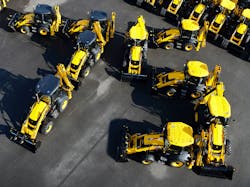JCB Timeline Traces 75 Year History
JCB celebrates its 75th anniversary this month, and has released a timeline encapsulating its growth from a garage in Uttoxeter in the United Kingdom in 1945.
The company began with the manufacture of a tipping trailer made from war time scrap, produced in the garage and sold for £45 at the town’s market.
1947: The company was expanding and moved a few miles down the road to a stable block at Crakemarsh Hall, which was owned by a Mrs Julia Cavendish, a survivor of the Titanic disaster. JCB hired its first full-time employee, Arthur Harrison, who became foreman.
1950: JCB moved to Rocester.
1953: The Mk 1 was launched, the first time a single machine had been produced with a hydraulic rear excavator and front mounted shovel. The JCB logo was also introduced and registered as a trademark in 1958.
1961: JCB Aviation was formed and the company’s first plane, a twin-engine de Havilland Dove, made its inaugural flight.
1962: The JCB Dancing Diggers first took a bow, and JCB’s first overseas subsidiary in Holland was opened.
1963: The JCB 3C backhoe was launched.
1964: With sales of £8 million, JCB gave its employees a share in a £250,000 bonus. In the same year, JCB exported its first machine to the U.S.—a JCB 4C backhoe loader.
1969: JCB produced a record 4,500 machines and was exporting more than half of them. It was in recognition of this export success that the company received its first Queen’s Award—the first of 27 such accolades.
1970: JCB opened a U.S. base in Whitemarsh, Maryland.
1973: Sales doubled to £40 million from 1971.
1972: JCB France opened.
1977: The Loadall telehandler was introduced, and has become one of the most successful products in JCB’s history. HRH The Prince of Wales toured the Rocester factory.
1978: JCB’s second factory was constructed in the UK, JCB Transmissions in Wrexham.
1979: Manufacturing began in India. Today JCB has factories in New Delhi, Pune, and Jaipur with India now JCB’s biggest market behind the UK.
1985: The 3CX Sitemaster backhoe loader was launched. JCB celebrated the production of its 100,000th backhoe.
1987: Britain’s first female Prime Minister, Margaret Thatcher, visited JCB’s World HQ and drove a machine off the production line.
1988: The JCB GT, a backhoe capable of 100 mph, was introduced. This promotional tool continues to draw the crowds wherever it appears around the world.
1990: JCB launched the Fastrac tractor, the world’s first high-speed, full-suspension tractor. It also launched the 2CX backhoe loader.
1991: Launch of the 1CX backhoe loader.
1997: The Teletruk forklift was launched.
1998: JCB opened its second factory in Wrexham, Wales.
1999: JCB opened JCB Earthmovers in Cheadle, Staffordshire.
2000: The first machines began rolling off the production line at JCB’s new North American headquarters in Savannah, Georgia.
2004: The 500,000th machine was produced. It had taken just short of 60 years to reach that milestone. The next half million machines would be produced in the next nine years. It was also the year that JCB launched the Dieselmax engine, manufactured at JCB Power Systems in
2005: JCB opened its factory in Pudong, China. It and announced its biggest-ever order, a $140 million deal to supply the U.S. Army with a high-speed backhoe loader for military engineering tasks, a machine known as the High Mobility Engineer Excavator (HMEE).
2006: JCB set a world record with the JCB Dieselmax streamliner car. Powered by two JCB Dieselmax engines, it reached speeds of 350.092 mph on the Bonneville Salt Flats to attain the record of the world’s fastest diesel car, a title it still holds today.
2008: JCB Heavy Products, which manufactures tracked and wheeled excavators, moved to its new factory on the outskirts of Uttoxeter.
2009: A £40 million investment in JCB’s factory in Ballabgarh, India, created the world’s biggest backhoe loader factory. HRH Prince William toured the company’s headquarters and helped employees celebrate the production of the 750,000th machine.
2011: JCB celebrated its heritage with the opening of the “Story of JCB,” a permanent exhibition marking the growth of JCB and the Bamford family’s roots in industry.
2012: Global manufacturing extended to Brazil
2015: JCB marked its 70th anniversary with the brand new 3CX Compact backhoe loader, a machine 35 per cent smaller than its bigger brother and designed to work on increasingly congested building sites.
2016: The company celebrated the production of the 200,000th Loadall telehandler. It took almost 30 years for JCB to sell the first 100,000 Loadalls but it has taken less than 10 for the next 100,000 to be sold. JCB also marked the production on its 100,000th mini excavator and celebrated 25 years of production of the Fastrac tractor. The JCB Hydradig was launched.
2017: A new range of JCB powered access equipment was launched. JCB marked the production of its 500,000th.
2018: JCB’s first electric excavator—the 19C-1E—was unveiled. The X Series crawler excavator was launched. The company started manufacturing site dumpers in Rocester.
2019: JCB set a Guinness World Record for the fastest tractor at Elvington Airfield in Yorkshire, reaching 103.6 mph, then broke the record with a speed of 153.771 mph later in the year. The company opened a new £50 million headquarters for JCB Germany.
2020: The 750,000th backhoe loader was produced. The 220X excavator powered by a hydrogen fuel cell has been undergoing rigorous testing at JCB’s quarry proving grounds for more than 12 months.
Source: JCB
